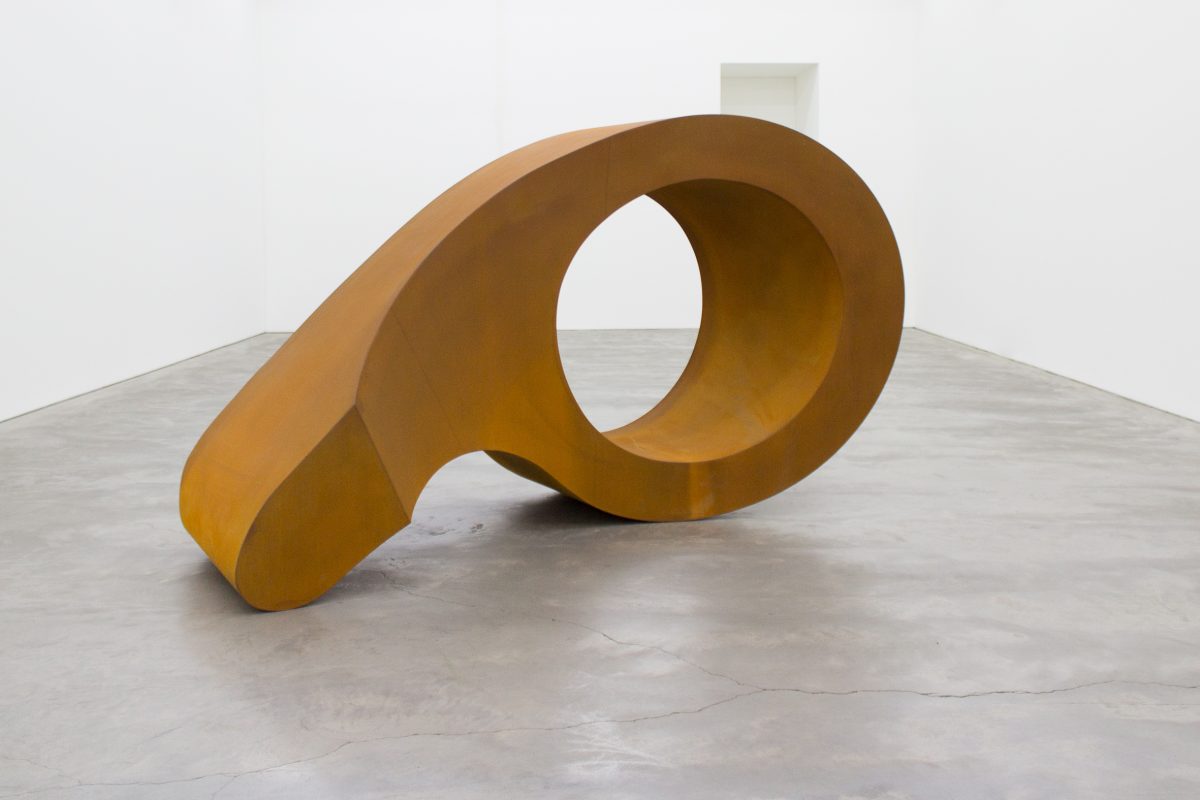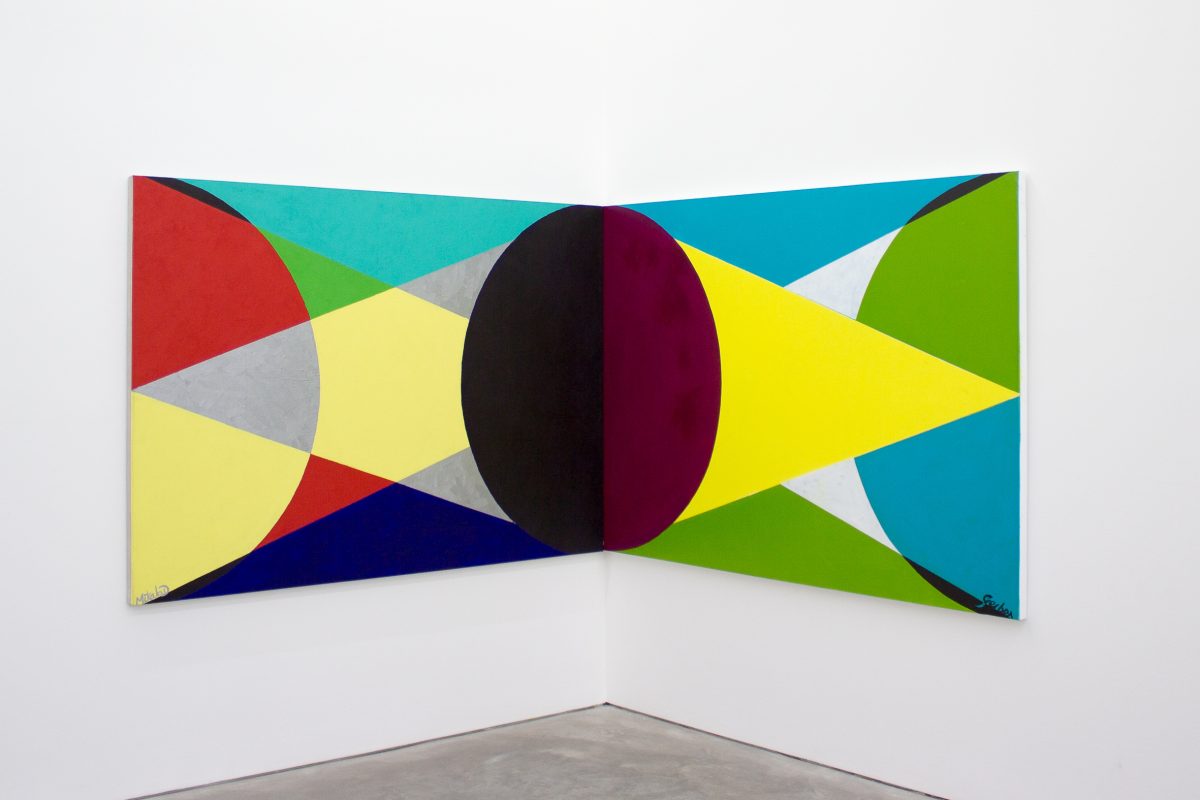Mikala Dwyer
Hollowwork
7th February – 29th March 2014
Anna Schwartz Gallery
The Conversion Artist
The apparent starkness and conciseness of Mikala Dwyer’s exhibition ‘Hollowwork’ belies an entangled network of connections. The seemingly non-navigable relationship between mind and body, the common line through the generations of a family, and the possibility of telepathic connection between minds are explored; joining across space and time with the works of Dwyer’s existing oeuvre, and those of her peers and precedents.
The immense orange-red steel form, ‘Hollowwork’, is Dwyer’s re-making of a ring that her mother, Dorothy Dwyer, once fabricated in silver. On such a scale the work also refers to the hard-edged formalist sculpture that was developed by artists of Dorothy Dwyer’s age; artists whose massive metal monuments now sit inconspicuously in the urban landscape of public parks and corporate forecourts. The cultivated rust of its surface is a deadpan reflection of the built environment of Melbourne, whose leading architects – those of the artist’s own generation – have clad the city in this same material, a substance that shows the effects over time of nature on the permeable surface of culture.
Beyond the often masculine statements of mid-century sculpture and contemporary architecture, ‘Hollowwork’ continues a distinctly feminine legacy. Passed from mother to daughter, the shape of the sculpture is awkwardly organic, like a fragment of pelvic bone; it also speaks of time: something ancient, archaic, passed down through ages, telescoping from the past into the future like a set of morphing Russian dolls, never truly empty. For Dwyer, the work is hollow not only in the jeweller’s terms (being fabricated around a void, thus being lighter to wear and consuming a smaller amount of expensive metal than a solid piece) but also ‘hollow’ in the sense that the artist herself has not invented the form, it is empty of her own hand. Of course, this modesty is unnecessary: Dwyer has applied to the ring a characteristic process of transformation and regeneration. This is less an emptying of meaning or idea, than a materialisation of the full scale of the original’s importance. When struck, a hollow object resounds and echoes, amplified.
Dwyer’s The weight of shape balances between ceiling and floor, hovering in and around the viewer’s field of vision. If ‘Hollowwork’ is the materialisation of a certain relationship, The weight of shape is a physical demonstration of thought patterns: at once geometric and organic; synthetic and natural; opaque and translucent; slick and porous; flat and voluptuous; at some moments static and then unexpectedly and uncontrollably mobile. A kind of corporeal daydream about the interior of the mind, The weight of shape provides an opportunity for the distinct departments of thinking to be negotiated physically, and perhaps rearranged. A mass of associations, the swinging objects are, again, fragments from the fertile zone of consciousness.
A collaboration between Dwyer and Matthys Gerber, the painted diptych Stepa Nova echoes Dwyer’s previous murals, such as the massive Spell for Corner in Dwyer’s exhibition ‘Goldene Bend’er’ at ACCA in 2013. Guided by a mutually-agreed set of formal and practice rules, the artists together set out a hard-edged abstract design and then, individually, selected exactly six colours, attempting to agree on this element without sharing any verbal or visual information. Trying to work together telepathically, each artist alone painted a panel of the ditych which now exists as the result of this experiment in working together, apart.
The title of the work invokes the Russian painter Vavara Stepanova (1854−1958), whose Constructivist compositions set art to use in service of a wider social good. It also goes some way to describe the process by which the artists arrived at this dually-authored piece, stepping over, transferring, and transgressing normal modes of communication.
A certain telepathy does indeed exist between each of Dwyer’s works, those here and many of those absent. It is as though the arc of these three new works are a section of a much larger iteration of Dwyer’s ongoing ritualistic circles The Additions and Subtractions. As in Avebury, Wiltshire, where the sweeping Neolithic circle of standing stone is simply too great to see as a whole, viewers of Dwyer’s work must experience each work in relation to its immediate neighbours, but read it from an imagined birds-eye view, or from the centre of the broad, empty circle.
The exhibition’s title, ‘Hollowwork’, is also specific to Dwyer’s treatment of the gallery space. Housed between the walls of the gallery and the forms of Dwyer’s scaled-up sculptures, peering through the tube of a corten ring, through loops of copper, to flat circles of acrylic, the viewer finds themselves inside the O, encircled, the negative space within the positive, the ground to the works’ figure. The void of the gallery is full of voids, and full voids at that. Like magic, Dwyer conjures something from nothing.
Images

Mikala Dwyer
Hollowwork (after Dorothy Dwyer), 2013
Corten steel
150 x 230 x 100 cm

Mikala Dwyer
The weight of shape, 2014
Acrylic, fibreglass, copper, ceramic, bronze, brass, stainless steel, steel and rope
Dimensions variable, approximate height: 350 cm

Mikala Dwyer
Stepa Nova, 2014
Acrylic on Belgian linen
127.5 x 366 cm


